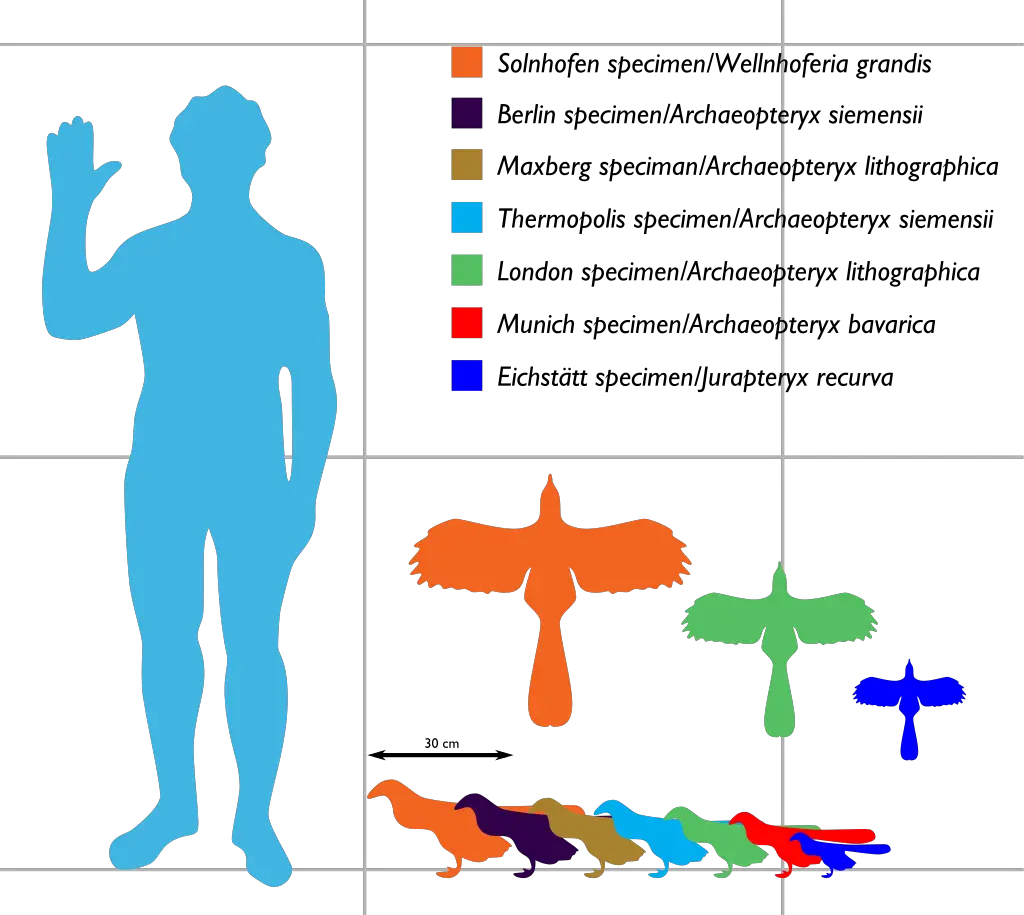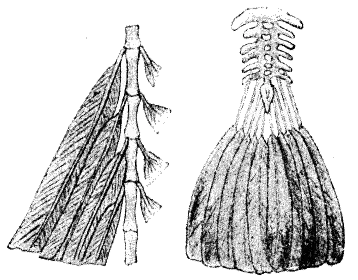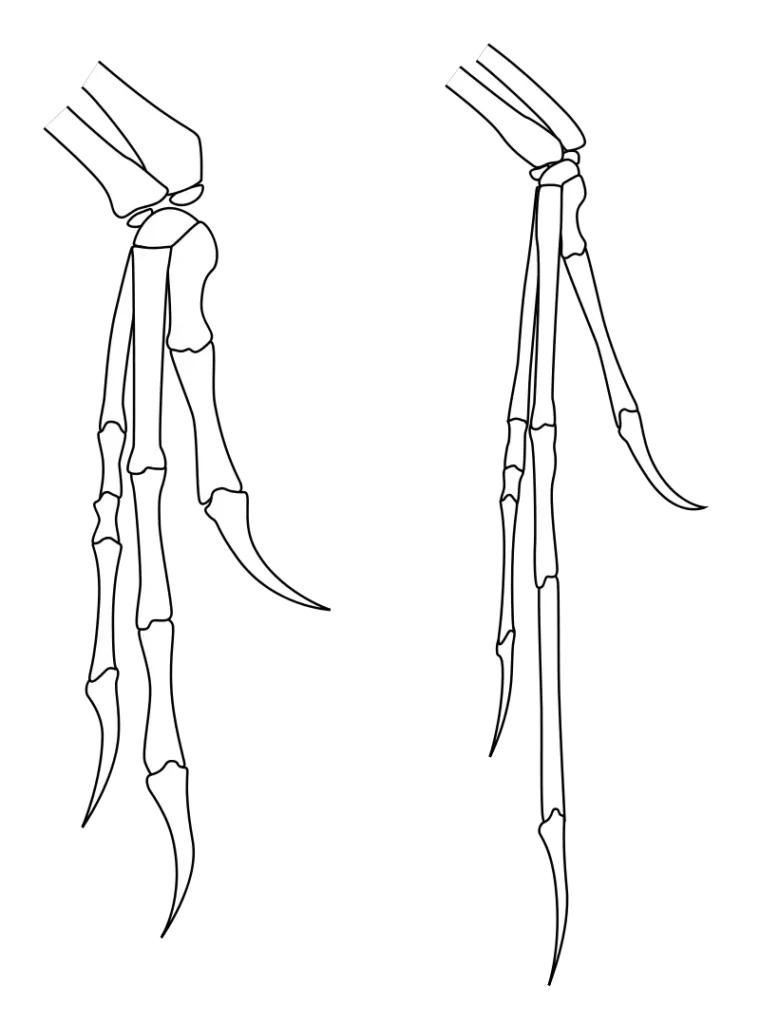What is Archaeopteryx?
- Archaeopteryx, also known as “Urvogel” or Primeval Bird, is a genus of avian dinosaurs.
- The name Archaeopteryx comes from the Greek words “archaīos” meaning “ancient” and “ptéryx” meaning “feather” or “wing.”
- It was initially considered the oldest known bird by paleontologists and reference books.
- However, older potential avialans have been discovered, challenging its status as the oldest bird.
- Archaeopteryx lived during the Late Jurassic, approximately 150 million years ago, in what is now southern Germany.
- It inhabited a region that was an archipelago of islands in a shallow tropical sea.
- Archaeopteryx was similar in size to a Eurasian magpie, with some individuals possibly reaching the size of a raven.
- Despite its ability to fly or glide and its bird-like features, Archaeopteryx shared more characteristics with small Mesozoic dinosaurs than with modern birds.
- It had sharp-toothed jaws, three-fingered hands with claws, a long bony tail, a hyperextensible second toe known as the “killing claw,” and feathers.
- These characteristics make Archaeopteryx a significant transitional fossil between non-avian dinosaurs and birds and contribute to the study of dinosaur evolution and the origin of birds.
- The first specimen of Archaeopteryx was named based on a single feather, but later, more complete specimens were discovered, totaling eleven fossils.
- The discovery of other feathered dinosaurs has raised questions about the exact ancestry and relationships of modern birds, but Archaeopteryx remains an important piece of evidence for the theory of evolution.
Discovery of Archaeopteryx
- Initial Discovery: A single feather was unearthed in 1860 or 1861 and described by Hermann von Meyer. It is currently located at the Natural History Museum of Berlin.
- The London Specimen: The first skeleton, known as the London Specimen (BMNH 37001), was discovered in 1861 near Langenaltheim, Germany, and sold to the Natural History Museum in London. It was described by Richard Owen in 1863.
- Meaning of the Name: The word “Archaeopteryx” combines the Greek words “archaīos” meaning ‘ancient, primeval’ and “ptéryx” meaning ‘wing’ or ‘feather’.
- The Berlin Specimen: The Berlin Specimen (HMN 1880/81) was discovered in 1874 or 1875 near Eichstätt, Germany. It is the most complete specimen and is displayed at the Berlin’s Natural History Museum.
- The Haarlem Specimen: The Haarlem Specimen (TM 6428/29) was discovered in 1855 near Riedenburg, Germany. It is currently located at the Teylers Museum in Haarlem, the Netherlands.
- The Eichstätt Specimen: The Eichstätt Specimen (JM 2257) was discovered in 1951 near Workerszell, Germany. It is currently located at the Jura Museum in Eichstätt, Germany.
- The Solnhofen Specimen: The Solnhofen Specimen (unnumbered specimen) was discovered in the 1970s near Eichstätt, Germany. It is displayed at the Bürgermeister-Müller-Museum in Solnhofen.
- The Munich Specimen: The Munich Specimen (BSP 1999 I 50) was discovered in 1992 near Langenaltheim and is currently located at the Paläontologisches Museum München in Munich.
- The Daiting Specimen: The Daiting Specimen was discovered in 1990 in Suevia. It was named Archaeopteryx albersdoerferi and is privately owned.
- The Bürgermeister-Müller Specimen: Another fragmentary fossil known as the Bürgermeister-Müller Specimen was found in 2000. It is on loan to the Bürgermeister-Müller Museum in Solnhofen.
- The Thermopolis Specimen: The Thermopolis Specimen (WDC CSG 100) was discovered in Bavaria and described in 2005. It is located at the Wyoming Dinosaur Center in Thermopolis, Wyoming.
- Additional Specimens: An eleventh specimen was discovered in 2011, and a twelfth specimen was found in 2010 at the Schamhaupten quarry.
Authenticity:
- Beginning in 1985, claims were made that the feathers on the Berlin and London specimens were forged. However, these claims were repudiated by experts.
- Evidence such as hairline cracks and mineral growth on the slabs support the authenticity of the feathers.
- Suggestions of forgery were largely based on misunderstandings of geology and were not taken seriously by paleontologists.
Description of Archaeopteryx

- Size: Archaeopteryx was roughly the size of a raven, with a body length of up to 0.5 meters (1 ft 8 in) and a wingspan of about 0.7 meters (2 ft 4 in).
- Weight: It had an estimated mass of 0.5 to 1 kilogram (1.1 to 2.2 lb).
- Fossil Origins: Most of the specimens of Archaeopteryx have been discovered in the Solnhofen limestone in Bavaria, southern Germany. This region is known for its well-preserved fossils from the early Tithonian stage of the Jurassic period, dating back approximately 150.8–148.5 million years ago.
- Avian Features: Archaeopteryx exhibited several avian features, such as broad wings with rounded ends and well-developed flight feathers. Its feathers had a structure similar to modern-day bird feathers.
- Non-avian Dinosaur Characteristics: Despite its avian features, Archaeopteryx also possessed non-avian theropod dinosaur characteristics. It had small teeth and a long bony tail, which it shared with other dinosaurs of its time.
- Link between Birds and Dinosaurs: Archaeopteryx has often been considered a transitional form between birds and non-avian dinosaurs. It displayed features common to both groups and provided evidence for the evolutionary connection between them.
- Fore-Legs and Claws: Archaeopteryx had three separate digits on each fore-leg, each ending with a claw. This feature is uncommon in most birds but can be found in some species like ducks, swans, Jacanas, and the hoatzin.
- Plumage: The flight feathers of Archaeopteryx were well-developed and asymmetrical, similar to modern bird feathers. Its tail feathers were less asymmetrical but still had firm vanes. The body plumage of Archaeopteryx is less well-documented, but the Berlin specimen revealed the presence of feathers on the legs and along the back.
- Colouration: A colour study conducted on an Archaeopteryx specimen suggested that it had black colouration, especially in the dorsal coverts. However, other studies have proposed complex light- and dark-coloured plumage, indicating that the precise colour patterns of Archaeopteryx remain uncertain.
How Archaeopteryx is a connecting link Between Reptiles and Birds (Aves)?
Archaeopteryx is considered a connecting link between reptiles and birds (Aves) due to its combination of characteristics from both groups. Here’s a description of how Archaeopteryx exhibits features that bridge the gap between reptiles and birds:
- Skeletal Features: Archaeopteryx shares several skeletal features with reptiles, particularly with theropod dinosaurs. It has a long bony tail, teeth, and a skeletal structure that resembles that of small carnivorous dinosaurs. These features are more reptilian than avian.
- Feathers: Archaeopteryx had well-developed feathers, which are a defining characteristic of birds. Its feathers were similar in structure to those of modern-day birds, with a barb-barbule-barbicel arrangement. This suggests that feathers evolved before the development of true flight.
- Flight Adaptations: While Archaeopteryx had flight feathers, it may not have been capable of sustained powered flight like modern birds. Instead, it likely possessed flight capabilities similar to gliding or short bursts of flapping flight. This transitional stage in flight adaptation is indicative of its reptilian ancestry.
- Wings and Wing Structure: Archaeopteryx had broad wings that were rounded at the ends, resembling the wings of birds. However, its wing structure also shows similarities to the forelimbs of reptiles, particularly theropod dinosaurs. This suggests that the evolution of flight in birds involved the modification of existing reptilian forelimbs.
- Claws and Digits: Archaeopteryx had three separate digits on each forelimb, each ending with a claw. This reptilian characteristic is not commonly found in modern birds but is present in certain reptiles. The presence of claws indicates that the hands of Archaeopteryx still retained reptilian features.
- Respiratory System: The respiratory system of Archaeopteryx is similar to that of birds. It possessed a unique avian lung structure called unidirectional airflow, which is highly efficient for supplying oxygen during flight. This respiratory system is a key adaptation for powered flight, connecting Archaeopteryx to avian characteristics.
- Transitional Anatomy: Archaeopteryx exhibits a combination of features that are intermediate between reptiles and birds. Its characteristics include a wishbone (furcula), flight feathers, wings, partially reversed first toe, and other dinosaur-like features. These traits provide evidence for the evolutionary transition from reptiles to birds.

By combining reptilian features like teeth and a long bony tail with avian features like feathers and flight adaptations, Archaeopteryx serves as an important transitional fossil, illustrating the evolutionary link between reptiles and birds. It provides valuable evidence supporting the theory that birds evolved from reptilian ancestors.

Here’s a comparison table highlighting the characteristics of Archaeopteryx that demonstrate its role as a connecting link between reptiles and birds (Aves):
| Reptiles | Archaeopteryx | Birds (Aves) |
|---|---|---|
| Skeletal Features | – Long bony tail | – Reduced tail length |
| – Teeth | – Toothless | |
| – Similar skeletal structure to theropod dinosaurs | – Modified skeletal structure for flight | |
| Feathers | – Absent | – Well-developed feathers |
| Wings | – Forelimbs not modified for flight | – Broad wings, adapted for flight |
| – Wing structure resembling reptilian forelimbs | ||
| Respiratory System | – Different respiratory system | – Unidirectional airflow for efficient flight |
| – Complex air sacs and lungs | ||
| Flight Adaptations | – Incapable of sustained powered flight | – Adapted for sustained powered flight |
| – Advanced wing adaptations for maneuverability | ||
| Claws and Digits | – Clawed digits on forelimbs | – Reduced digits, specialized for perching |
| – Few or no claws on digits | ||
| Transitional Traits | – Shared features with theropod dinosaurs | – Combination of reptilian and avian features |
| – Presence of avian characteristics like | ||
| feathers and wishbone (furcula) | ||
| – Partially reversed first toe |
Description:
Archaeopteryx, as a connecting link between reptiles and birds (Aves), exhibits a range of characteristics that show its transitional nature:
- Skeletal Features: While reptiles and theropod dinosaurs possess a long bony tail and teeth, Archaeopteryx shows a reduction in tail length and retained teeth. This indicates a transition towards bird-like characteristics.
- Feathers: Reptiles lack feathers, while Archaeopteryx possesses well-developed feathers similar in structure to those of modern birds. This suggests the evolutionary development of feathers for flight.
- Wings: Reptiles do not have specialized forelimbs for flight, but Archaeopteryx displays broad wings that are adapted for flight. The wing structure of Archaeopteryx shares similarities with the forelimbs of reptiles and theropod dinosaurs.
- Respiratory System: Reptiles have a different respiratory system, whereas Archaeopteryx exhibits a more bird-like respiratory system with unidirectional airflow, an important adaptation for efficient oxygen supply during flight.
- Flight Adaptations: Unlike reptiles, Archaeopteryx possesses flight adaptations such as modified wings and flight feathers. While it may not have been capable of sustained powered flight like modern birds, it likely had gliding or short bursts of flapping flight.
- Claws and Digits: Reptiles typically have clawed digits on their forelimbs, whereas Archaeopteryx retains this reptilian characteristic. In contrast, modern birds have reduced digits specialized for perching and often lack claws.
- Transitional Traits: Archaeopteryx exhibits a combination of reptilian and avian features. It shares traits with theropod dinosaurs, such as a wishbone and partially reversed first toe, while also displaying avian characteristics like feathers and flight-related adaptations.
These comparisons demonstrate how Archaeopteryx displays a mosaic of features that link reptiles and birds, providing valuable evidence for the evolutionary transition from reptilian ancestors to avian species.
FAQ
What is Archaeopteryx?
Archaeopteryx is a genus of extinct bird-like dinosaurs that lived approximately 150 million years ago during the late Jurassic period.
How is Archaeopteryx considered a connecting link between reptiles and birds?
Archaeopteryx exhibits a combination of reptilian and avian characteristics, displaying traits shared by both reptiles (such as a long bony tail and teeth) and birds (such as feathers and flight adaptations).
What are some reptilian features of Archaeopteryx?
Reptilian features of Archaeopteryx include a long bony tail, teeth, clawed digits on its forelimbs, and skeletal similarities with theropod dinosaurs.
What avian characteristics does Archaeopteryx possess?
Archaeopteryx has well-developed feathers similar to those of modern birds, flight adaptations like broad wings, and avian respiratory features for efficient oxygen supply during flight.
Did Archaeopteryx have the ability to fly?
While Archaeopteryx likely had limited flight capabilities, it may not have been capable of sustained powered flight like modern birds. It likely had gliding or short bursts of flapping flight.
How do the wings of Archaeopteryx resemble reptilian forelimbs?
The wing structure of Archaeopteryx shares similarities with the forelimbs of reptiles and theropod dinosaurs, suggesting a transition from reptilian forelimbs to bird wings.
What is the significance of feathers in Archaeopteryx?
Feathers in Archaeopteryx represent an important evolutionary development. They provide evidence of the early stages of feather evolution and their role in flight adaptation.
How does the respiratory system of Archaeopteryx differ from reptiles?
Unlike reptiles, Archaeopteryx exhibits a more bird-like respiratory system, including air sacs and unidirectional airflow, which are important for efficient respiration during flight.
Are there any living birds that share similarities with Archaeopteryx?
Some living birds, such as certain flightless birds like ostriches and emus, share some characteristics with Archaeopteryx, such as reduced wings and vestigial claws.
Why is Archaeopteryx considered an important fossil in the study of evolution?
Archaeopteryx is considered a crucial transitional fossil that provides evidence for the evolutionary link between reptiles and birds. It helps us understand the gradual development of avian characteristics from reptilian ancestors.
- Text Highlighting: Select any text in the post content to highlight it
- Text Annotation: Select text and add comments with annotations
- Comment Management: Edit or delete your own comments
- Highlight Management: Remove your own highlights
How to use: Simply select any text in the post content above, and you'll see annotation options. Login here or create an account to get started.